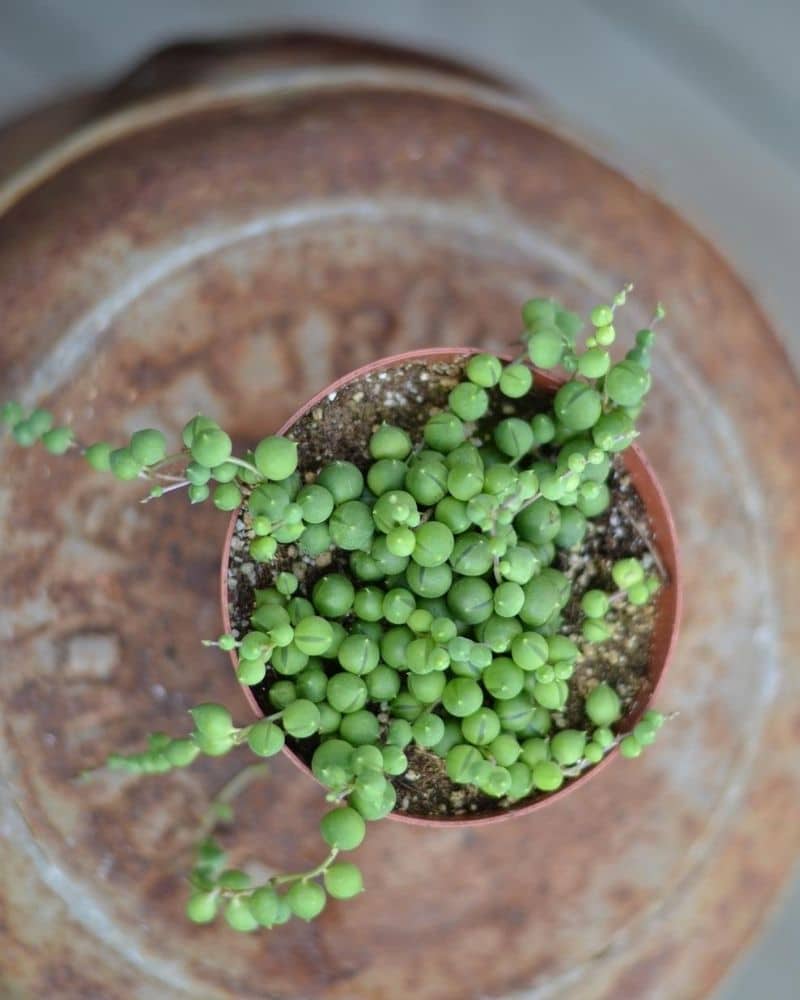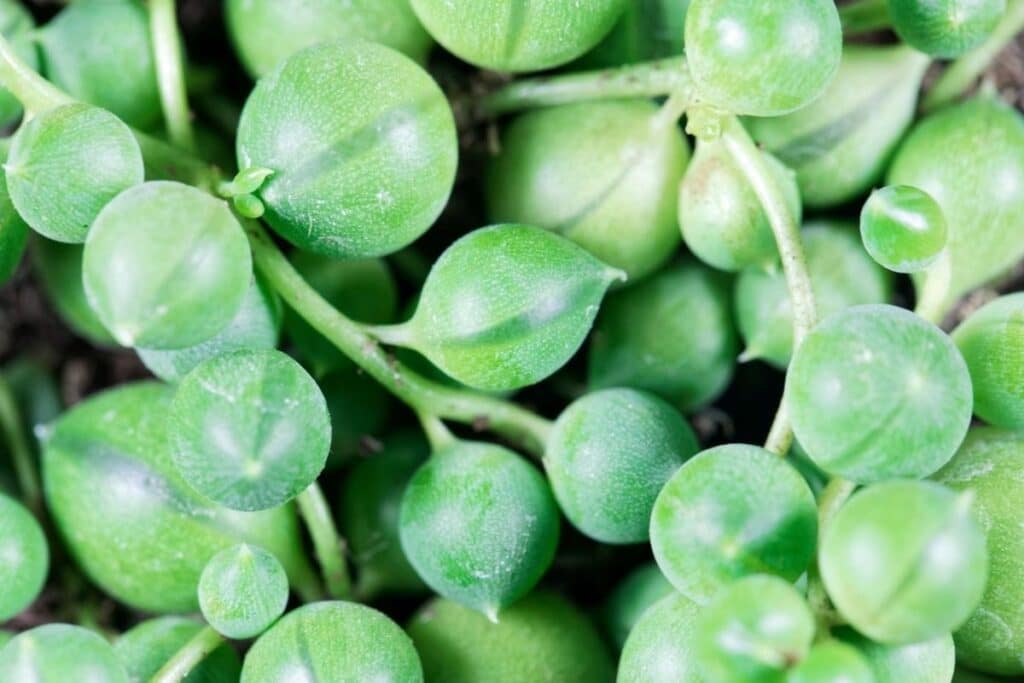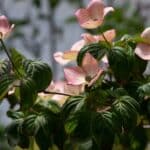For a plant enthusiast, it can be a challenge to bring greens into the house, especially if the indoor is not that spacious to begin with.
Most of the appliances and furniture we have occupy the ground and the lower half of the house and as much as we enjoy upright and potted indoor plants, they will only take up more of the already limited space.
That is why a hanging plant is the best solution to this indoor gardener’s blues. They not only make use of the vertical space of the house but keep it tidy and healthy too. A perfect plant to grow fitting to this kind of situation is none other than the string of pearls!
What is a String of Pearls?

String of Pearls or Rosary Pearls, scientifically known as Curio rowleyanus or Senecio rowleyanus, is actually a unique member of the Aster family. It was recently moved to this genus so some literature may still refer to it under the genus Senecio.
Considered a succulent, it has string-like stems bearing pearl or pea-like green leaves (hence the common name) that form a thick mat when planted on the ground or spill over its container when elevated in hanging baskets (1).
String of pearls is one of the toughest Curio species, being able to store moisture and withstand a relatively different environment indoors. It originated from the Eastern Cape in South Africa and was cultivated as a houseplant because of its hardiness and unusual but appealing foliage (2).
Does Senecio Rowleyanus Bloom?
String of pearls is grown for its tiny melon shaped leaves but it blooms rather insignificant flowers in summer. It produces tiny fragrant dandelion-like flowers that easily dry out which can look untidy so some gardeners prefer cutting them off as soon as they appear (3).
What is the Lifespan of String of Pearls?
A parent plant of rosary pearls can last for years, if given the right care. They will tend to lose vigor in 5 years, especially if kept on the same pot and soil for too long.
String of Beads are easily propagated by stem cuttings so the original plant can give rise to multiple new plants to continue growing them. This makes them one of the best plants for indoors.
How to Take Care of String of Pearls
Light and Water
String of pearls thrives in bright indirect light. Place it near a window where it can receive plenty of bright, indirect sunlight throughout the day. Direct sunlight, especially during the hottest parts of the day, can scorch the delicate leaves, so protect it from harsh midday sun. If your plant isn’t getting enough light, it may become leggy and lose its compact shape.
Watering is perhaps the trickiest part of string of pearls care. These plants are succulents, meaning they store water in their leaves and stems, and they’re sensitive to overwatering. Allow the soil to dry out almost completely between waterings. Stick your finger into the soil about an inch deep—if it’s dry, it’s time to water. Water thoroughly, but make sure excess water can drain away freely.
During the growing season (spring and summer), water more frequently, but still let the soil dry out between waterings. In the dormant season (fall and winter), reduce watering to prevent root rot.
Soil and Fertilizer
Well-draining soil is crucial for this succulent. Sandy soil works best. Consider using a cactus soil mix or create your own blend by mixing potting soil with sharp sand in a three-to-one ratio. Remember that these pearls plants are susceptible to root rot, so ensure the soil is well-draining.
During the spring and summer growing seasons, keep the plant’s soil lightly moist, and then cut back on the watering in the winter.
Fertilize String of pearl plants sparingly during the growing season with a balanced, water-soluble fertilizer diluted to half strength. Apply the fertilizer once a month to provide essential nutrients for healthy growth.
Avoid fertilizing during the dormant period in fall and winter, as the pearls plant is not actively growing. Over-fertilizing can lead to salt buildup in the soil and cause damage to the shallow root system.
Temperature and Humidity
Good air circulation easily achieved by hanging is ideal for this plant. Be careful not to place them in too humid areas as this will cause the round leaves to drop. From time to time, it will need to be brought outdoors, hung by the patio.
String of pearls likes its climate mild and temperatures between 21-24 ̊C is preferred that’s why string of pearls are observed thriving in coastal areas (3). During winter, do not let the temperature drop below 13 ̊C to keep the plant healthy and maybe allow it to bloom.
Pests and Diseases
Being a succulent, the string of pearls is vulnerable to sucking insects like aphid and mealybug. They turn the leaves yellow and sooty and even cause premature leaf drop. But these attacks are very manageable, often eradicated by regular application of insecticidal soap. Make sure to watch out for early signs so as to avoid severe infestation that could lead to death of the plant.
Additionally, ensure that your string of pearls receives indirect sunlight rather than direct sun, as excessive exposure to direct sunlight can harm the plant.
Propagation and Maintenance
Rosary pearls is a popular spiller plant (1). As it grows, the string stems will drip down the pots for as long as 6 feet and upon closer inspection, small aerial roots will be observed. This allows the pearl plants to be propagated by cuttings.
3-4 inch stem cuttings are stripped of 3-4 leaves from the bottom. This part will be covered by soil and misted regularly until roots grow and establish. They can form thick mats as these trailing stems eventually elongate and produce new roots. Be vigilant for any signs of dead stems, which may need pruning or removal.
Foliar fertilizer should be applied to established plants twice a year, in early autumn and late spring (4).
Repotting this curio plant will help replenish the soil nutrients and keep the roots well aerated. A porous compost potting mix formulated for cacti and succulents is also ideal for this plant. Transplanting should be handled with care as the plant’s leaves can be delicate and will fall apart when roughly touched (2).
Best Cousin Plants of String of Pearls to Grow
1. String of Bananas or Fish Hooks (C. radicans)
Tougher than the String of pearls, this species can tolerate full sun half the time and likes it bright. As the name suggests, the tapering leaves look like minute green bananas but in brighter conditions, the leaves become thinner making them look like curved fish hooks instead. Interestingly, this resemblance is not uncommon among closely related plants
2. String of Watermelons (C. herreanus)
This species is even more attractive with its green pointed bead leaves lined with purple stripes like tiny watermelons. Like the other curio plants, each leaf had a translucent segment that absorbs light for photosynthesis.
3. String of Tears (C. citriformis)
The teardrop-shaped leaves of this plant are soft and whimsical with the frosted appearance. In summer, tiny yellow flowers complement the velvety tears.
4. String of Dolphins (C. peregrinus)
A hybrid between C. articulates and C. rowleyanus, String of dolphins is also a spiller that showcases small curved leaves that look like dolphins jumping mid-air. This plant prefers dappled shade but will do well near a bright window.
FAQs
Does string of pearls need direct sunlight?
String of pearls prefer bright, indirect sunlight but can tolerate some direct sunlight, especially in the morning or late afternoon. However, avoid exposing them to intense, direct sunlight for extended periods, as it can scorch their delicate leaves.
How often should I water string of pearls?
Water string of pearls thoroughly when the top inch of soil feels dry to the touch, typically every 2-3 weeks. Ensure proper drainage to prevent waterlogging, which can lead to root rot. Adjust the watering frequency based on environmental conditions such as temperature and humidity.
Does string of pearls multiply?
Yes, String of pearls can propagate and multiply through various methods, including division, offsets, and stem cuttings. With proper care and conditions, individual pearls can develop roots and grow into new plants, leading to the expansion of your string of pearls collection.
Can string of pearls grow from a cutting?
Yes, string of pearls can grow from cuttings. Simply take a healthy stem cutting with several pearls and allow the cut end to callus for a few days. Then, plant the cutting in well-draining soil, water lightly, and provide bright, indirect sunlight. With time and proper care, the cutting will develop roots and grow into a new string of pearls plant.
References
Reference List
(1) Tuttle, C. “Succulents”. 2015. Penguin. P. 288.
(2) Kirton, M. “An Hour in the Garden”. 2006. Allen & Unwin. P. 191.
(3) Baldwin, D. “Succulents Simplified: Growing, Designing, and Crafting with 100 Easy-care Varieties”. 2013. Timber Press. P. 272.
(4) Martin, T. “The Indestructible Houseplant: 200 Beautiful Plants that Everyone can Grow”. 2015. Timber Press. P. 288.
Close
Image by ChWeiss/depositphotos







